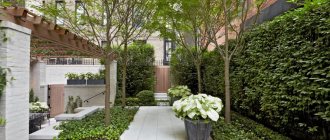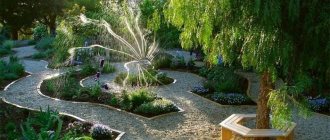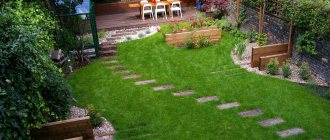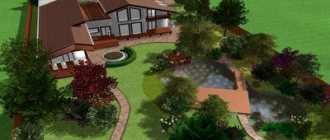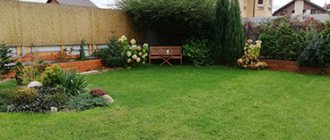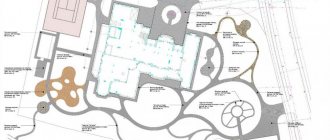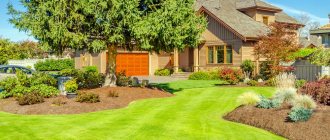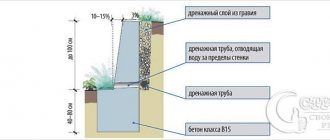Landscape design can work wonders. You probably have a question: how can an inanimate plot of land, planted with plants, strewn with stones and decorative elements, create something? Very simple. Go to a city park or visit the main attraction of a city. What a pleasant atmosphere there. What feelings does such a place give you? Most likely, very pleasant and warm. Isn't this a miracle? Place, shapes, colors can convey so many feelings and emotions, tell about their creator, his life and interests. Famous and sought-after designers are so imbued with the idea that they are able to create truly impressive objects of landscape art.
Landscape design of a site is the creation of beauty and harmony around your home
Tips for Newbies
Russian universities train certified design specialists. But design is not science, but creativity. Creativity, as everyone knows, is unique and unique in its manifestations. In other words, every person who creates landscape objects contributes a drop of their own, unique and one-of-a-kind soul. Only by listening to the prompts of their subconscious, famous designers created historical architectural compositions that have survived to this day. But they were not recognized immediately; time had to pass. Therefore, there is no need to be afraid to take the initiative in arranging your site. Sometimes, the most extraordinary and strange decisions create a unique atmosphere of the territory and reveal the true beauty of the human soul.
It takes a lot of work to create a practical place for the whole family to relax
In order to learn the basic lessons of landscape design, advance preparation is required. At this stage, it is necessary to take time to study reference books, manuals and magazines dedicated to the design of suburban areas and their gardens. Fortunately, the Internet is generous as always. In these books you will find tips from designers who will share secrets with you, show you the most common mistakes of beginners, and direct your aspirations in the right direction.
Always start small and realize your ideas slowly, enjoying the process itself, and not just its result
Of course, nothing can replace live communication with a person. But if you find a suitable book written by a competent author, you will absorb the makings of a true landscape master.
A good garden design has several compositional centers that attract attention. It can be anything - a tree, bush, pond or bench
Usually two or three books read within a week inspire the newly minted creator to such an extent that he immediately runs to the nearest gardening supply store and buys everything he thinks he needs. Starting from decorative elements and ending with flowers and trees. This is strictly prohibited. Rushing will not lead to success; you will only forget what little you have learned. First you need to figure out the order, following which you will be able to choose the right material for the fence and gazebo. The further choice of elements of small architectural forms, trees, flowers and plants depends on this.
Start your path to your dream garden with one small flower bed or mixborder
Go out into the garden when you have time and desire, work and don’t try to do everything at once and in one day
See alsoDesign of gazebos in different styles.
Analysis of existing styles in the organization of parks and gardens in private areas
Regular (geometric or French) style
– such a garden or park has clear symmetrical lines, a geometrically correct layout of all objects. Planning such a park begins with identifying the main central line, which carries the main semantic load. All alleys are based on straight lines, flower beds and regularly shaped pools. Shrubs and trees are trimmed.
English (landscape park) park
– is divided taking into account the natural location of all objects. The style originated in England in the 18th century after the Baroque era went out of fashion. The foundations of this style are distinguished by beautiful smooth natural lines, paved with paving stones or stone paths. All objects preserve their natural appearance as much as possible, which is not the case in French parks. Also a distinctive feature of such gardens is the tiered approach to planting.
Chinese style
– the basics of this style are characterized by complete harmonization when placing garden compositions. Everything is subject to the laws of Eastern philosophy and has a deep sacred meaning, which is not found in European cultures.
Japanese gardens
is a small demonstration of the worldview of the Japanese nation. Everything has its true purpose and occupies a strictly defined place. The first principles and foundations of the organization of Japanese packs were developed by Buddhist monks. They reflect the perfection of the natural world, and sometimes the entire universe.
Muslim (Moorish garden) –
a reflection of Eastern wisdom and slowness. The aromas of exotic flowers, birdsong, and the quiet murmur of ponds completely contribute to relaxation and tranquility. In eastern countries, parks and garden areas have always been a piece of heaven on earth. When arranging the architecture of the park, all the laws of Islam are strictly respected. It was under the palaces of the eastern rulers that gardening art received its active development.
The harmony and beauty of the natural islands of the garden have a good effect on physical fitness and mental balance. Scientific research has long established the facts of the positive influence of nature and the proper organization of the environment on the emotional state of a person. A well-thought-out and sophisticated design of a backyard area will bring joy and pleasure to its owner. This is only possible if all the customer’s wishes were analyzed and taken into account when drawing up the work program. It often happens that even the most expensive and fashionable works of designers cause unpleasant feelings. Conversely, simple and uncomplicated landscapes created with your own hands delight the eyes and soul, instilling calm and tranquility.
In order for a person to relax in his garden and get rid of everyday hassles, the design must be carried out in accordance with certain rules and include an analysis of all factors influencing the natural environment and the architecture available on the site.
Basic principles of landscape design
- The first thing you need to do is analyze the backyard territory and understand the topography of the site. Further development largely depends on this.
- Dividing land into zones. This includes marking on the plan of the recreation area, garden (vegetable garden) and small architectural forms.
- Marking of garden paths. They should provide ease of movement between zones, taking into account the width of the aisles.
- Determination of the general composition of zones and architectural forms. At this stage, the choice of building material, its color and shape occurs, as well as the determination of the color of the paths and the material for their manufacture.
- Selection of green spaces and flowers. At this stage, varieties of trees (their shapes) and flowers are selected, as well as the territorial location of mixborders and alpine slides.
Consider scale and visualization to accommodate plant growth
An important point in landscape design is the size of the plot. The arrangement of flower arrangements, as well as the choice of location for planting trees, depends on them. In a small area, there is a need to visually enlarge it. This effect can be achieved by different methods. One of them is the correct selection of the color of the fence and asymmetrical planting of coniferous trees along it. Here you need to understand that the square or rectangular shape of the fence creates some kind of frame. To remove them, the fence is painted in light colors, and the trees are planted in groups of 4-5 in a row.
Each element of the garden should fit organically into the overall landscape composition
Trees must be purchased at least half a meter higher than the fence. Due to this, a visual expansion is created.
Conifer hedge
If you want to add depth to your hedge, plant trees in a staggered pattern.
They also arrange alpine slides, which can be supplemented with multi-colored stones. A good idea to expand the territory would be to install a medium-height slide with a stream. And at the foot of the stream, a small pond is dug, along the banks of which a moisture-loving fern can be planted. If we talk about the recreation area behind the house, then such an object is best placed near the fence. A climbing carpet of ivy is allowed onto the fence. Such a cascade of architectural forms will create a perspective effect, that is, an external observer, when contemplating this beauty, will feel the depth of space, richness and volume.
Against the backdrop of a perfectly trimmed lawn, a path made of concrete slabs, the area around which is covered with small pebbles, looks good
The article mentions small architectural forms. They can also be found on the Internet under the abbreviated name MAF. For a person unfamiliar with this concept, below are the main elements of the MAF involved in landscape design.
- Terraces, verandas and gazebos.
- Trellis, pergolas and arches.
- Garden fences, mixborders, fountains and sculptures.
- Ponds, streams and bridges across them.
- Other decorations, ranging from free-standing vases with flowers to garden gnomes.
Wooden bridge over a dry stream
Beautiful decoration of a blind fence
In addition, every person living in the city meets MAF every day. These are bus stops, telephone booths, city and park benches and many other elements.
See alsoLandscape design of a site on a slope
Rules of geometric shapes
When planning to transform a garden plot, everyone wants to achieve harmony. But creating the necessary picture is not always easy. The rules of geometric shapes will help you avoid problems. The tradition of using correct forms dates back to antiquity. An example is the regular garden of Versailles, founded during the era of the French monarchy.
Did you know? Nature
is the best designer.
This can be seen in the example of the “Chocolate Hills” in the Philippines, which have a perfectly even cone shape and are presented in quantities of more than 1,770 pieces. on the territory of the island Bohol. The entire composition is based on 3 rules of geometric shapes:
- triangle;
- square;
- circle.
Triangle
The triangle rule is based on the selection of 3 heights, 3 shapes, 3 colors. But the components must be combined in different proportions - 8:3:1.
Design according to the triangle rule:
- forms - multi-format, small elements complement larger ones;
- height - details are arranged according to the descending principle: large ones in the background, small ones in the foreground;
- color - choose 2 main ones, for example, white and orange, then add a small amount of contrasting color (purple, blue or any other).
You can experiment with shades within the chosen style. When combined, the rule of the circle will help.
Square
This law is based on the location of the 4 cardinal directions. This is one of the tips for the designer, indicating how to place vegetation - each element has its own place and conditions.
You will be interested to know what to plant irises with beautifully.
Nuances of applying the square rule:
- arrangement of plants on the site, taking into account their botanical characteristics;
- colors look different in different conditions - for example, white flickers in the shadows and glows in foggy weather, but in bright light it is lost against the general background;
- direct sunlight depletes the color range, pushing even an unusual shade towards the primitive spectrum (yellow, blue, red), so it is better to decorate open areas in a yellow-red palette;
- blue tone visually expands the space;
- at sunset, the red tint is the last to go, so the western part of the territory should be decorated in a burgundy-violet-red spectrum with a white background.
Circle
The rule of the circle allows you to vary the color spectrum. There is a special design circle that shows a combination of warm and cool shades. If you visually divide the space of the circle in half, then on the right there will be warm colors (from yellow to red), and on the left - cold colors (from green to blue).
As already written above, black, white and gray tones are neutral, so they are not found in the design circle. But they are necessarily present in the composition itself. The main thing is to rely on the principles of simplicity and the rule of the triangle when combining colors. This will help achieve a harmonious picture.
Terraces, gazebos and pergolas
These structures play the same role in the landscape design of the land. They are built to create a relaxation area, do your favorite things and just have a good time. Their distinctive features are their location relative to the country house, as well as their design.
Outdoor terrace with gazebo and grill area
Pergola came to our country from abroad. Its historical homeland is Italy. The design of this object is simple: four or six support beams are topped by horizontal partitions on the roof. Most often it is made of wood, less often of metal.
Corner pergola made of wood with a sofa for private relaxation
It is undesirable to use metal, as it gets very hot in the sun and can damage the plants entwining its elements.
Climbing plants are used to create shade in the space under the pergola. It is preferable to choose densely creeping grapes. It grows without flowering, but has a non-uniform leaf shade (from dark green to burgundy and even red). The space under the pergola is equipped with garden furniture that is resistant to precipitation. Also, in some cases, you can place a swimming pool under it. This solution is convenient in very hot climates.
Climbing plants can hide anything, anywhere
On an open terrace it is practical to use rattan furniture with removable cushions
A place to relax can be arranged either on a stone-paved platform or on a wooden platform
The construction of a terrace implies its location near the house, or rather, it is attached to it. The main difference between such a structure and a veranda is its open placement. That is, there is no canopy or one wall. This characterizes the building as a purely summer recreation option. If you plan to use the terrace in winter, then it is made with sliding glass doors, which is very convenient. But then it will no longer be a terrace, but a combined veranda.
Original terrace with a seating area inside
Closed gazebo for winter recreation
The construction of a gazebo implies the presence of garden furniture, a fireplace and a barbecue.
When installing a gazebo, you need to pay attention to the presence of a leeward side. If there is one, then one wall needs to be made blank, or vines should be planted.
The blank wall of the gazebo is placed on the leeward side
See alsoHow to design a summer cottage plot of 6 acres
Additional materials
For those who are not yet ready to take courses, there are many useful materials on the Internet that you can find and study on your own and sometimes even for free. The disadvantage of such lessons is that there is no structure, and some of the information becomes outdated. But you can create a certain impression about the activities of a landscape designer.
Let's watch some interesting videos.
- Lecture “Landscape design and garden planning”
- Games with space. Landscape tricks
- Broadcast of the lesson “Easy care garden”
- Walking mode in the Realtime landscaping Architect program
Courses often recommend literature or make it available for download. You can also find and read books on the profession yourself. Here are some good tutorials:
- “Garden Design” by Tom Brooks;
- “The Garden Designer's Handbook” by Rosemary Alexander;
- “Garden design. Professional approach” Rosemary Alexander, Karena Batstone;
- “Dendrology” Gromadin A.V., Matyukhin D.L.;
- "Hedges. Elements of garden design” Sapelin A. Yu.;
- “Creating a beautiful flower garden” by I. Bochkova.
16.06.2021
137
30 best books on landscape design
Hello, friends! Tell me, who among you would not like to have...
Studying is work, and learning on your own is many times more difficult than receiving ready-made diagrams, tools and cases. If you are determined to learn a new profession, I still advise you to learn from specialists and receive structured knowledge in a concise and convenient form. It's much faster and more efficient.
Seven tips for beginners
- When organizing the overall style of the landscape, all zones should overlap with each other. The smooth lines of paths and tree crowns are complemented by the rectangular shapes of gazebos or other buildings.
- For a relatively small area, use methods to visually increase space.
- Installing flowerpots in several levels will save space and also simplify the daily care of flowers and plants.
- If the garden plot is located on a slope, which means a large amount of ground work, you can take advantage of this in favor of the design. Install decorative retaining walls using natural stone. Also in this case, alpine slides, a pool or a pond are arranged at the lowest levels of the ground.
- If there are particularly large differences in ground level, it is necessary to organize the site into several levels, separated by retaining walls. From the point of view of landscape design, in such areas it is possible to arrange extraordinary and very beautiful architectural compositions. The only downside is the decent cash investment.
- On large land holdings it is possible to install a fountain and large flower arrangements. If finances do not allow you to purchase a fountain, then you can make decorative elements with your own hands, such as boats, windmills, or multi-level flower arrangements. Also an excellent solution would be to organize a large alpine slide.
- Before choosing one design option or another, you need to reconsider different combinations and combinations of architectural elements. To visually represent compositional solutions, use computer programs that allow you to combine MAFs and pre-evaluate your presentation. The advantage of this software is the presence of tips and ready-made images and solutions.
Stones of various sizes and shapes create the effect of a mountain landscape
Color in the landscape is the most important rule for creating the desired effect. The main one is always green, but splashes of other shades give greater expressiveness.
Perennial flowers and shrubs require less care than annuals, and they should be used as the basis for landscaping
Landscape design is a very interesting and rewarding endeavor. You will get a lot of positive emotions and have a great time with your family.
Low-growing flowers are planted along the edges of the flower bed, and large ones are planted closer to the center of the flower bed.
Landscaping a suburban area is a long process, taking several years.
Expert opinion
Alina Kvileva
Landscape designer
Hello, my name is Alina and I am a landscape designer, if you have any questions regarding landscape design, ask, I will be happy to answer them.
See also: DIY country decor from scrap materials
Taking site measurements
Many people will have a question about where to start measuring. First of all, you need to transfer to your plan all unchangeable points and buildings on the working area (this can be gazebos, a house, a bathhouse and other buildings), and it is also worth taking into account and recording the trees and shrubs that will remain on the site. After basic sketches have been made, you need to move on to taking measurements. The algorithm of actions is as follows:
- Using a soft tape measure, you need to measure the total area of the working area.
- If the yard or garden plot will be divided into different zones, then you need to take measurements of each sector separately. It is worth knowing how much free space you can use in your work. It is important to measure every free sector without losing sight of the slightest detail.
Using a metal tape measure, you need to measure permanent objects, their height and width, and the distance at which they are from the reporting points. By the way, it is important initially, before you start taking measurements, to decide on your starting points. This could be a building or other important landmark. Professional designers call such measurements “krok”; in addition to the distance, they should take into account the direction of the light; this is why a compass is needed in the work.
Don't forget to measure not only the width, but also the height of objects
Photos of landscape design and garden decorations
About the tricks of the color palette
The space of the site is much larger than the space of the home, which makes it tempting to fill it with a variety of decor. But for decorating a site yourself, the basic requirement is simplicity of design; this also applies to the color palette of the landscape. The site will make a favorable impression if the colors of the composition are chosen correctly. It is useful to use the following color selection techniques:
- Buildings on a site (house, gazebo, garage) are rarely made in the same color, and there is no need to try to make them the same. To make them look cohesive, it is useful to use some common architectural element. This could be shingles on all roofs or wood trim throughout.
- One of the buildings can be made the center of the composition. Then it is highlighted in color using contrast.
Gazebo Source peredelka.tv
How to plant a lawn with your own hands
As we have already said, the lawn is the basis from which we will build . There are several types of lawns. For beginners, it is better to make a universal one; it will not require serious care and is quite suitable for any purpose. And the main goal is beauty, neatness and convenience for relaxation.
If the ground where the lawn is planned is clean, it will need to be dug up, leveled, compacted, and then sown with seeds. They need to be covered with dry soil on top to prevent birds from pecking them.
Very often the desire to arrange a lawn appears even when the dacha has been built a long time ago, and you want to finally highlight and decorate a corner for relaxation. Usually there is a place where company constantly gathers, barbecue is grilled and there are sun loungers. The grass grows there in patches; no one has touched it for many years, and the earth is already heavily compacted.
This is a “difficult” case for a novice landscape designer.
First of all, we get rid of weeds once and for all!
Nowadays, chemicals are used for this, which are used to water the weeds and then dig them up. The substance penetrates to the very roots and the plant dies. After this procedure, the soil should rest for at least 2 weeks.
Those who deny any gross interference in the affairs of nature can simply uproot the grass from the ground and wait until it begins to sprout again. After 3-4 weeks, we remove the sprouts that appear again and carefully dig them up. The soil should be loose, without lumps. Before digging, it is advisable to add mineral fertilizers. They will help the new young grass grow quickly and gain strength.
Then we sow the area with lawn grass. We choose a universal lawn mixture. Why is it suitable for us?
Advantages:
- unpretentious in care;
- withstands shade and lack of moisture;
- frost-resistant.
Note! It is unlikely that you will be able to get a good lawn right away. You'll have to work hard for a couple of seasons.
Until the cultivated grass has grown, it will be necessary to constantly remove weeds, otherwise they will “kill” the young growth. You may have to reseed areas where birds pecked at the seeds, or where for some reason the seed did not sprout.
But after going through all the difficulties, it will be possible to walk barefoot on a thick lawn every year.
Rules of care:
- We mow in dry weather (wet grass is difficult to mow evenly).
- We don’t let it grow too much (it will be difficult to even it out).
- Water during drought (but don't overwater!).
Where to start
More recently, some 15-20 years ago, a summer cottage was only a place for planting vegetables and berries. People came there to weed, water and collect a generous harvest, which was certainly preserved, salted or pickled. A rare piece of land was not planted with “useful” plants. There were few flowers and ornamental plants; they were planted only in front of the house or along the path; there was no talk of landscape design.
But not all summer residents wanted to collect only a large harvest. There have always been gardeners who designed original flower beds that involuntarily attracted the gaze of passers-by and aroused the admiration of their neighbors. Apparently, it was precisely these people who began to actively “introduce” new design ideas for landscaping a dacha into our consciousness. Gradually, a craving for beauty began to awaken in every summer resident.
Today, almost every plot owner wants to have at least a small recreation area in their garden, decorated with original plants, flowers, a picturesque pond or an alpine hill.
Looking at a photo of some landscape design, the average person will decide that it is unrealistic to do this himself. But if you follow the saying “the eyes are afraid, but the hands do,” then you can gradually decorate your plot quite decently.
Main stages of work:
- think about what we want and where we will place it all
- sow the lawn;
- pick up plants.
You can arrange a gazebo, barbecue area, pond or alpine slide. In some areas there will be room for all this, while others will have to limit themselves to a couple of elements.
IMPORTANT! A lawn is an essential part of landscape design; simple weeds look sloppy and will disrupt the harmony of the entire display.


